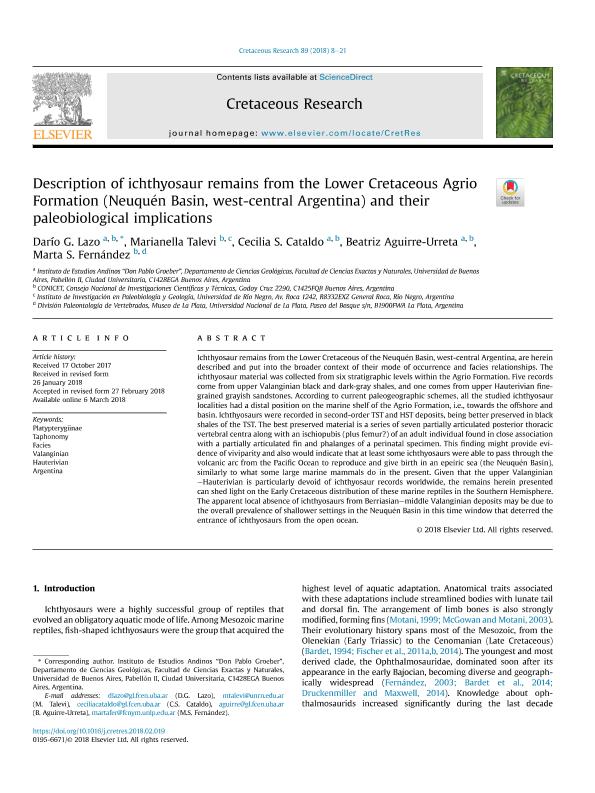Mostrar el registro sencillo del ítem
dc.contributor.author
Lazo, Dario Gustavo

dc.contributor.author
Talevi, Marianella

dc.contributor.author
Cataldo, Cecilia Soledad

dc.contributor.author
Aguirre-Urreta, Maria Beatriz

dc.contributor.author
Fernández, Marta Susana

dc.date.available
2019-11-08T23:59:37Z
dc.date.issued
2018-09
dc.identifier.citation
Lazo, Dario Gustavo; Talevi, Marianella; Cataldo, Cecilia Soledad; Aguirre-Urreta, Maria Beatriz; Fernández, Marta Susana; Description of ichthyosaur remains from the Lower Cretaceous Agrio Formation (Neuquén Basin, west-central Argentina) and their paleobiological implications; Academic Press Ltd - Elsevier Science Ltd; Cretaceous Research; 89; 9-2018; 8-21
dc.identifier.issn
0195-6671
dc.identifier.uri
http://hdl.handle.net/11336/88401
dc.description.abstract
Ichthyosaur remains from the Lower Cretaceous of the Neuquén Basin, west-central Argentina, are herein described and put into the broader context of their mode of occurrence and facies relationships. The ichthyosaur material was collected from six stratigraphic levels within the Agrio Formation. Five records come from upper Valanginian black and dark-gray shales, and one comes from upper Hauterivian fine-grained grayish sandstones. According to current paleogeographic schemes, all the studied ichthyosaur localities had a distal position on the marine shelf of the Agrio Formation, i.e., towards the offshore and basin. Ichthyosaurs were recorded in second-order TST and HST deposits, being better preserved in black shales of the TST. The best preserved material is a series of seven partially articulated posterior thoracic vertebral centra along with an ischiopubis (plus femur?) of an adult individual found in close association with a partially articulated fin and phalanges of a perinatal specimen. This finding might provide evidence of viviparity and also would indicate that at least some ichthyosaurs were able to pass through the volcanic arc from the Pacific Ocean to reproduce and give birth in an epeiric sea (the Neuquén Basin), similarly to what some large marine mammals do in the present. Given that the upper Valanginian–Hauterivian is particularly devoid of ichthyosaur records worldwide, the remains herein presented can shed light on the Early Cretaceous distribution of these marine reptiles in the Southern Hemisphere. The apparent local absence of ichthyosaurs from Berriasian–middle Valanginian deposits may be due to the overall prevalence of shallower settings in the Neuquén Basin in this time window that deterred the entrance of ichthyosaurs from the open ocean.
dc.format
application/pdf
dc.language.iso
eng
dc.publisher
Academic Press Ltd - Elsevier Science Ltd

dc.rights
info:eu-repo/semantics/openAccess
dc.rights.uri
https://creativecommons.org/licenses/by-nc-sa/2.5/ar/
dc.subject
ARGENTINA
dc.subject
FACIES
dc.subject
HAUTERIVIAN
dc.subject
PLATYPTERYGIINAE
dc.subject
TAPHONOMY
dc.subject
VALANGINIAN
dc.subject.classification
Paleontología

dc.subject.classification
Ciencias de la Tierra y relacionadas con el Medio Ambiente

dc.subject.classification
CIENCIAS NATURALES Y EXACTAS

dc.title
Description of ichthyosaur remains from the Lower Cretaceous Agrio Formation (Neuquén Basin, west-central Argentina) and their paleobiological implications
dc.type
info:eu-repo/semantics/article
dc.type
info:ar-repo/semantics/artículo
dc.type
info:eu-repo/semantics/publishedVersion
dc.date.updated
2019-08-08T19:09:44Z
dc.journal.volume
89
dc.journal.pagination
8-21
dc.journal.pais
Estados Unidos

dc.journal.ciudad
Nueva York
dc.description.fil
Fil: Lazo, Dario Gustavo. Consejo Nacional de Investigaciones Científicas y Técnicas. Oficina de Coordinación Administrativa Ciudad Universitaria. Instituto de Estudios Andinos "Don Pablo Groeber". Universidad de Buenos Aires. Facultad de Ciencias Exactas y Naturales. Instituto de Estudios Andinos "Don Pablo Groeber"; Argentina
dc.description.fil
Fil: Talevi, Marianella. Consejo Nacional de Investigaciones Científicas y Técnicas. Centro Científico Tecnológico Conicet - Patagonia Norte. Instituto de Investigación en Paleobiología y Geología; Argentina
dc.description.fil
Fil: Cataldo, Cecilia Soledad. Consejo Nacional de Investigaciones Científicas y Técnicas. Oficina de Coordinación Administrativa Ciudad Universitaria. Instituto de Estudios Andinos "Don Pablo Groeber". Universidad de Buenos Aires. Facultad de Ciencias Exactas y Naturales. Instituto de Estudios Andinos "Don Pablo Groeber"; Argentina
dc.description.fil
Fil: Aguirre-Urreta, Maria Beatriz. Consejo Nacional de Investigaciones Científicas y Técnicas. Oficina de Coordinación Administrativa Ciudad Universitaria. Instituto de Estudios Andinos "Don Pablo Groeber". Universidad de Buenos Aires. Facultad de Ciencias Exactas y Naturales. Instituto de Estudios Andinos "Don Pablo Groeber"; Argentina
dc.description.fil
Fil: Fernández, Marta Susana. Consejo Nacional de Investigaciones Científicas y Técnicas. Centro Científico Tecnológico Conicet - La Plata; Argentina. Universidad Nacional de La Plata. Facultad de Ciencias Naturales y Museo. División Paleontología Vertebrados; Argentina
dc.journal.title
Cretaceous Research

dc.relation.alternativeid
info:eu-repo/semantics/altIdentifier/url/https://www.sciencedirect.com/science/article/pii/S0195667117304494
dc.relation.alternativeid
info:eu-repo/semantics/altIdentifier/doi/https://doi.org/10.1016/j.cretres.2018.02.019
Archivos asociados
